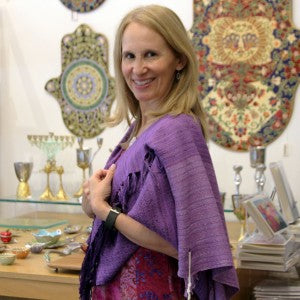והָיָה לָכֶם, לְצִיצִת, וּרְאִיתֶם אֹתוֹ וּזְכַרְתֶּם אֶת-כָּל-מִצְוֺת יְהוָה, וַעֲשִׂיתֶם אֹתָם; ולֹא-תָתוּרוּ אַחֲרֵי לְבַבְכֶם, ואַחֲרֵי עֵינֵיכֶם, אֲשֶׁר-אַתֶּם זֹנִים, אַחֲרֵיהֶם.
And it shall be unto you for a fringe, that ye may look upon it, and remember all the commandments of the Lord, and do them; and that ye go not about after your own heart and your own eyes, after which you go astray;
-Numbers 15:39
The ritual of the Tallit dates back to the years the Jewish nation spent in the desert, traveling their circuitous route from the far shores of the Red Sea to the borders of the Land of Israel. The Book of Numbers relates that God commanded the people to tie fringes, literally tzitzit, to the corners of their garments as a reminder of the centrality of God’s commandments in their lives. When they would be confronted by tests or temptations, they had to look no further than their own clothing to be re-centered in their holy service of God.
 The Jewish Tallit has remained much the same since then. Four corners, each adorned with a specially knotted skein of thread. The strings are tied with five double knots with seven coils in the first space, eight in the second, eleven in the third, and thirteen in the fourth. These 39 coils have the same numerical value as “Hashem Echad,” G‑d is One. Traditionally, through biblical and Talmudic times, some of the threads were dyed with techelet, a blue-purple dye whose origin has been lost to history. Today some have the custom to dye the tzitzit with dyes as similar as possible to the original techelet in order to reconnect with the original practice of this mitzvah.
The Jewish Tallit has remained much the same since then. Four corners, each adorned with a specially knotted skein of thread. The strings are tied with five double knots with seven coils in the first space, eight in the second, eleven in the third, and thirteen in the fourth. These 39 coils have the same numerical value as “Hashem Echad,” G‑d is One. Traditionally, through biblical and Talmudic times, some of the threads were dyed with techelet, a blue-purple dye whose origin has been lost to history. Today some have the custom to dye the tzitzit with dyes as similar as possible to the original techelet in order to reconnect with the original practice of this mitzvah.
As the Jewish people has traveled and scattered, the materials have evolved, the design has taken on a regional flavor, but the construction has remained the same. Just as the tallit gave the wandering people something concrete to hold onto in the desert, those same tzitzit have provided reassurance, inspiration, and connection through Jewish travels and exiles through the centuries.
Over time, the Tallit has also taken on new roles. It wraps the wearer during prayer, and in Jewish burial customs it shrouds the departed. It may be used as a marriage canopy, and in chassidic communities, a three year old is enveloped in it on his way to learn the Aleph Bet. The Tallit cocoons, creating an intimate sacred space, full of possibility and holy connection. A Jewish Tallit is also a symbol. It is a recurring theme in the dream-like paintings of Marc Chagall, and was one of the few items that accompanied astronaut Jeffrey Hoffman into space in 1996. Seen on shoulders at rallies and protests, and hidden in the concentration camps of the Holocaust, it is one of the symbols of the invincibility and integrity of the Jewish nation.
Today, the tallit reflects the wearer. Silk or wool, many colors or transcendent in its simplicity, each person may choose their own symbol. In this way, tallitot serve as one of the many ways Judaism allows us to bridge our individuality with our communal customs. However we choose to represent ourselves through our tallit, the very action of wearing a tallit ties us inexorably to each other and our shared history. It is the space within, created by the tallit, that is the most precious. We are reminded that whatever is taking place outside, there is connection, tradition, and history inside the tallit.




